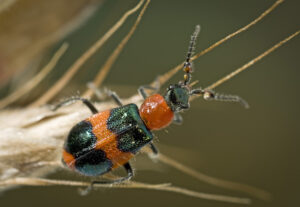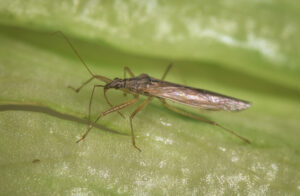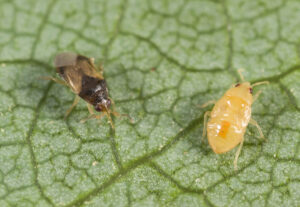
Overlooked predatory insects
By Denis Crawford
We are all familiar with predators such as ladybird beetles and lacewings, but some of the less familiar predators are just as important.
Ladybird beetles are certainly the most well-known predators and common species are instantly recognisable with their bright colours and dark spots. There is an equally brightly coloured beetle that may occur in your gardens, nurseries or orchards – the prosaically named ‘red and blue beetle’. It is technically known as Dicranolaius bellulus, and it is a member of the beetle family Melyridae (the so-called ‘soft-winged flower beetles’). This beetle may also be known as a ‘pollen beetle’, although that name is used for several other beetles as well.
Dicranolaius bellulus is found throughout eastern Australia and a related species occurs in Western Australia. The adult beetle is metallic red and dark blue in colour, hence its common name, and it is 5−8 mm long. Males and females are similar in appearance except for their antennae. Male beetles have one segment of their antennae greatly enlarged, while the antennae of female beetles are more uniform.

Dicranolaius bellulus is an important predator of the eggs and small larvae of several moth pests including potato moth, budworms and loopers (and possibly the eggs of other pests), as well as aphids. Adult beetles may congregate on flowers, where they may feed on the pollen. This is not a bad thing; it is likely they act as pollinators while feeding. Red and blue beetle eggs, larvae and pupae occur in the soil. The larvae are scavengers and predators also, but it is the adult beetle that is the most effective predator.
The most well-known predatory bugs are assassin bugs (Reduviidae) and predatory shield bugs (Pentatomidae). But there are others. Damsel bugs (Nabidae) are common but often overlooked predatory bugs. About 20 species occur in Australia. Damsel bugs are slender, long-legged insects. Adult damsel bugs grow to about 10 mm long with wings that fold along the length of their bodies. Immature bugs (nymphs) are miniature versions of adults, but without wings. All forms of this predatory insect are grey-brown in colour which can make them difficult to see. Damsel bugs are more likely to be found in low-growing plants rather than in trees. They are sometimes mistaken for plant-feeding bugs because they may feed on nectar when prey is not available.
The cosmopolitan damsel bug (Nabis kinbergii) is found in all Australian states and mainland territories. Damsel bugs prey on soft-bodied insects such as small caterpillars, aphids, leafhoppers and moth eggs. Because they are such prolific feeders on pests they are considered to be important biological control agents in a range of Australian crops. Female damsel bugs insert their eggs into leaves or stems of plants, often in neat rows, near where prey insects are. Hatching nymphs begin feeding on available food immediately. Do you see them in your nursery or gardens?

Minute pirate bugs Orius spp. of the family Anthocoridae are predators of small insects such as aphids and thrips, insect eggs, small caterpillars, other immature insects and mites. They are also known as ‘flower bugs’ because they feed on nectar as well as insects. The commercially available species Orius armatus is marketed as a predator of thrips.
Adult minute pirate bugs are tiny insects less than 3 mm long (hence the word ‘minute’ in their common name). They are somewhat flattened, black or brown in colour with dark red eyes. They have white markings at the base of their forewings, giving the wings a banded appearance. Nymphs are wingless, fast-moving insects that are pear-shaped, orange in colour with bright red eyes.
The most unusual insect predators are the predatory caterpillars. Mataeomera dubia is a native moth of the family Noctuidae. Its larvae feed on several species of scale insects including black scale, grapevine scale, soft brown scale, and pink wax scale. The larvae of Stathmopoda melanochra, a native moth of the Oecophoridae family, are predators of gumtree scale. These caterpillars are unlikely to bring scale infestations under control on their own, but they may be important as part of a mix of predators. For example, a scale infestation may be targeted by ladybird beetles and parasitic wasps as well as predatory caterpillars.

Some thrips species are predatory upon other insects, including pest thrips, and mites. A few species are obligate predators meaning they usually only feed on certain insects or mites, while others are facultative predators meaning they feed on both plants and prey. The thing to be aware of is the thrips you see on your flowers may not necessarily be damaging them – you need to take a closer look.
The most well-known obligate predatory thrips are the red scale predator Aleurodothrips fasciapennis, the scale predator Karnyothrips flavipes, the spider mite predator Scolothrips sexmaculatus (an introduced species), and Haplothrips spp., which are predators of pest thrips and mites.

Haplothips is a problematic genus because not all species are predators – many feed and breed in flowers. So how would you know whether a particular thrips is a predator or a plant feeder that might be a problem? Predatory thrips often look similar to pest thrips. Colour can vary considerably, and thrips may be pale yellow, red, dark brown or black, depending on the species and on whether or not it’s an adult or larval thrips. Being small insects, you could use a hand lens to see if the thrips on your plants are feeding on other insects and mites or feeding on your plants. For example, if you look closely at the image of the red thrips (larval form of a Haplothrips species) printed here, you will see it has a grip on the larva of another species of thrips. It’s safe to assume it’s a predator.
The Haplothrips species I see in western Victoria is probably H. victoriensis which is a widely distributed species. Haplothrips victoriensis occurs in eastern Australia from southern Queensland to Tasmania, as well as northern Western Australia. The adult thrips is a dark brown (almost black) insect which is very active and has a flexible abdomen. The take-home message is that not all thrips are pests, and some are beneficial and should be encouraged. Thrips are sensitive to insecticides, so the best way to encourage a population of predatory thrips is to minimise the use of pesticides. The same advice applies to the other beneficial insects mentioned here.
Main image: Male red and blue beetle (images supplied by Denis Crawford)
